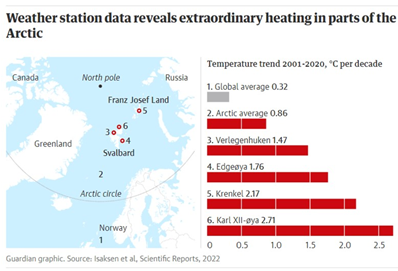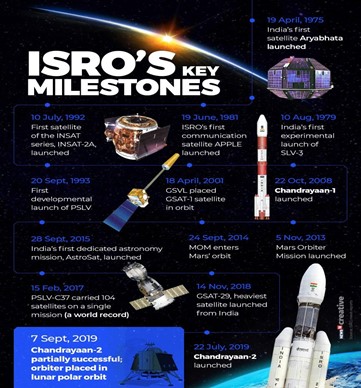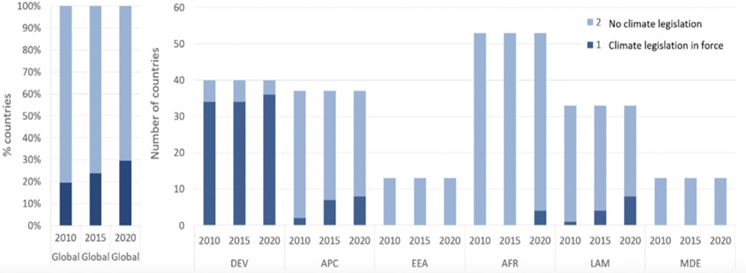24 Jan
Global North vs. Global South: The Climate Divide
Why in news: Climate negotiations continue to be shaped by equity concerns between postindustrial countries in the Global North and emerging economies in the Global South.
Background: The most affluent countries of the world, also referred to as the “Global North”, produce a carbon footprint 100 times greater than that of the world’s poor nations combined together referred as “Global South “
Global North vs Global South
- Global North includes the US, Canada and Western Europe, the developed part of Asia, Australia and New Zealand. While the global South is made up of regions such as Africa, Latin America and developing Asia including the Middle East.
- The distinction is not only about the different environmental priorities of the North and the South; it is about the different ultimate goals that each seeks from the global environmental politics”.
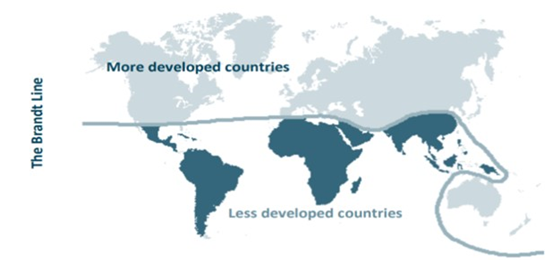
What Is Climate Colonialism?
- Exploitation of resources and power by Global North countries in dealing with climate change and environmental policies.
- Global North abuses its position of power to ‘export’ its solutions abroad.
CASE STUDYCarbon offset projects purchased to claim a smaller carbon footprint without truly reducing the amount of GHG emissions produced. Reforestation projects are done in countries in the Global South, such as in Brazil and Ecuador, and have been shown to involve land grabs from indigenous people, who are evicted from their homelands |
Ecological Crisis & Global South
- Farmers in India have had their crops and farmlands ruined by unusual snowstorms and destructive heatwaves.
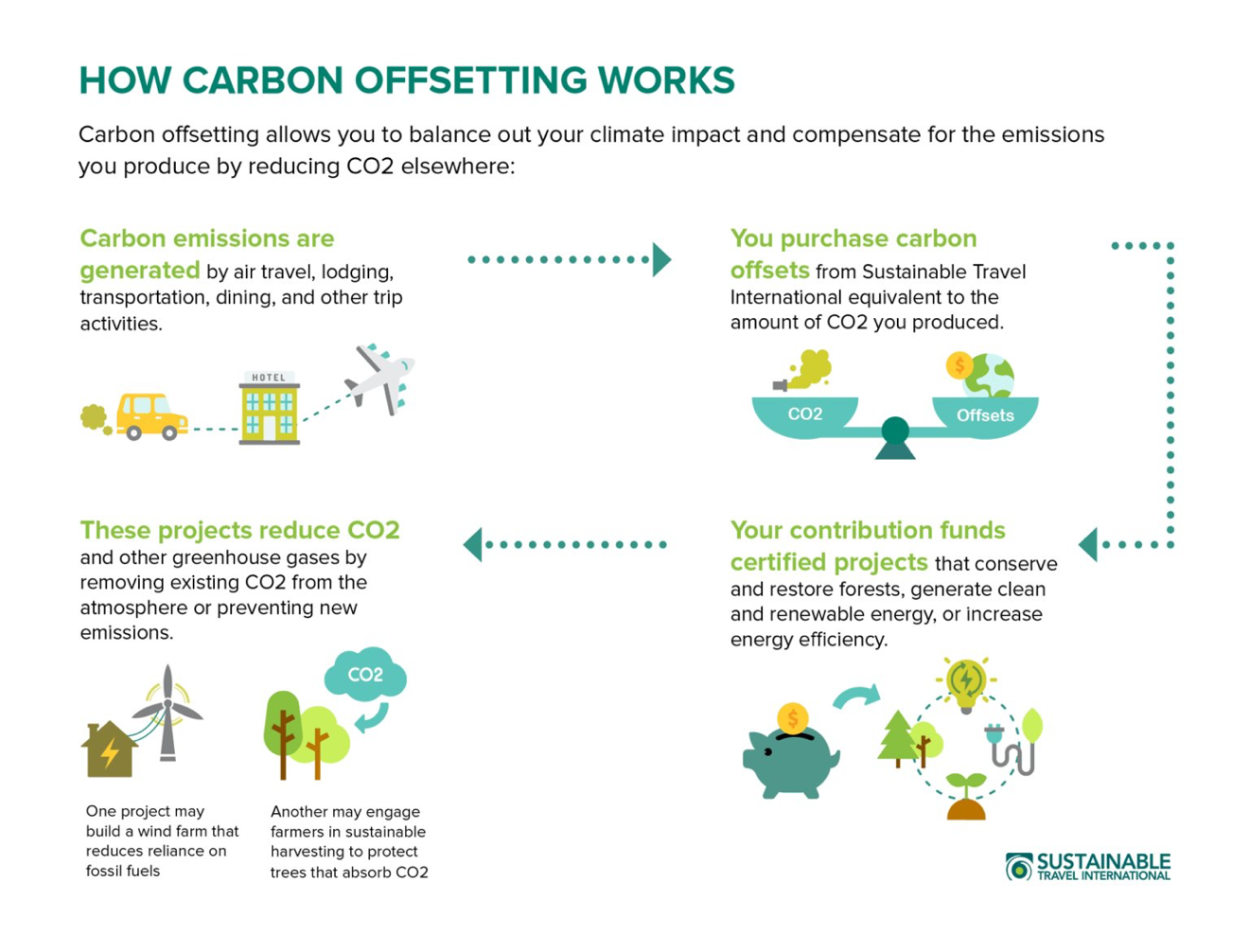
- Mozambique has been devastated by a series of cyclones, which have grown more potent as the planet warms.
- Droughts in Madagascar have forced people to flee their homes in search for more habitable lands.
- Brunei, Cambodia and others are identified as countries where the “impact of sea level rise will be particularly severe”
- South Africa due to its water scarcity is severely affected by food security and hunger.
How Deep Is The Climatic Divide?
- Asymmetry between countries’ emissions and their respective burdens to respond to climate change .
- Human-driven GHG emissions are by affluent countries but burden of the impacts of climate change is carried by poorer nations.
- Contrast between past emissions and future emissions. Emissions of China and India are on a upward trajectory.
- Global south demanding immediate answers from post industrialised nations.
- Equity principle in the adjustments of climates change is still a debate between the two groups.
- Another highly divisive issue between the two is the potential impact of the carbon pricing schemes.
Adaptability and Survivability of Global North and South
- Developing countries at receiving end: Vulnerable countries tend to be the poorest. Countries that face the least harm - are best equipped to deal with the harm and tend to be the richest.
- Geographical advantage: Large industrialized countries are more resilient partly because of geography; they are mostly in mid-latitude regions with Goldilocks climates - neither too hot nor too cold.
- Economic endurance: Bigger factor is their wealth - United States, where just 4 percent of the economy is in agriculture, can endure a climatic setback far more easily than a country like Malawi, where 90 percent of the population is engaged in agriculture.
- Change in precipitation: Global precipitation is shifting away from the equator towards the poles. This will increase agricultural production in regions like Canada and Siberia, but leave drought-prone countries such as Kenya even shorter of water then they are at present.
- Wealth gap: Number of funds have been created to support adaptation, the few hundred million dollars that have been pledged is only a tiny fraction of the tens of billions of dollars needed to allow poor countries to adapt adequately.
Ideal Prrinciples of Environmental law to be followed
- Precautionary Principle: If there is a strong suspicion that a certain activity may have environmentally harmful consequences, it is better to control that activity now rather than to wait for incontrovertible scientific evidence.
- Prevention Principle: Fundamental notion behind laws regulating the generation, transportation, treatment, storage, and disposal of hazardous waste and laws regulating the use of pesticides.
- Polluter pays principle: Those who produce pollution should bear the costs of managing it to prevent damage to human health or the environment
- Integration principle: Due consideration be given to the potential consequences of environmentally fateful decisions.
- Public participation principle: An instrument of prevention, as it contributes to the democratic control of decision-making in environmental matters.
- Sustainable Development Principle: Essential needs of especially the poor are met in the present without compromising the future generation's ability to meet their needs.
Climate finance initiatives by Global North
|
Global Environment Facility (GEF) |
Five conventions rely on the GEF as a "financial mechanism":
|
|
Green climate fund (GCF) |
Fund with the mission of assisting developing countries in raising and realising their Nationally Determined Contributions (NDC). |
|
Special climate change fund |
Focused on two areas: adaptation and technology transfer |
|
Least developed countries fund |
Prioritises the design and execution of National Adaptation Programmes of Action (NAPAs), that identify LDCs' immediate adaptation requirements. |
Climate Financing in India
|
National Adaptation Fund for Climate Change |
Designed to fulfill the objectives of National Action Plan on Climate Change (NAPCC) and operationalize the State Action Plans on Climate Change (SAPCCs) |
|
National Clean Energy Fund |
To support clean energy innovation and research while funding clean energy projects |
|
Clean Energy Cess |
Carbon tax levied on coal produced in India or imported coal at the rate of Rs. 400/tonne |
Concerns regarding Climate Finance
- Definition of Climate Finance: Definition of the term “climate finance” is yet to be agreed internationally. Developed countries stifled discussions on the definition of climate finance, crucial to the determination of finance flows.
- No scientific analysis: $100 billion commitment in the UNFCCC figure is not enough and the number was not a product of sufficient analysis. 75% of the climate finances raised by the rich nations are used domestically.
- Flow of money: The money flow for climate finance is irregular. It is heavily biased towards mitigation and the adaption activities are lagging behind.
- The attitude of the well-off: The US decision not to pay the remaining $2billion of their contribution is alarming. Developed countries had met only up to a quarter of their commitment.
- Viability of Climate funding: The climate change projects have a long gestation period. The threatening slowdown does not help either as most countries and corporations are going for cost-cutting which almost always affects badly on climate finance.
Way forward:
- Recognise that the Global South and the Global North face different realities, implying different capacities, resources as well as different priorities on the political agenda.
- Recognising that climate change is a consequence of the unprecedented acceleration in human production and consumption.
- Modern idea of economic progress that harms the environment and its people is no longer considered the most suitable option for the well-being of the Earth.
- Focus on dealing with climate change in a more inclusive and equitable manner.
Conclusion:
Climate justice advocates point out that solutions should be inclusive. Any attempts by the Global North to dictate the world’s response to the climate crisis is an example of neocolonialism. Instead, climate conferences should take into account the opinions and capabilities of the people who are most affected by climate change and be receptive to non-western methods of adaptation.
Where to use?
Paper 2 GS optional (Ecological issues, Issues related to Environment) GS 3 (Environment Conservation)
LAND SUBSIDENCE IN JOSHIMATH
Why in news: Joshimath, Uttarakhand has been declared as a landslide and subsidence-hit zone.
About:
The land subsidence in Joshimath has increased rapidly with the Himalayan town sinking by 5.4 cm from December 27 to January 8, according to the National Remote Sensing Centre (NRSC).

What is land subsidence?
- Gradual settling or sudden sinking of the Earth’s surface due to the removal or displacement of sub-surface earth materials.
General Causes of Land Subsidence:
- It includes aquifer-system compaction associated with groundwater withdrawals, drainage of organic soils and underground mining.
- Also caused by natural events such as earthquakes, soil compaction, glacial isostatic adjustment, erosion, sinkhole formation, and adding water to fine soils deposited by wind.
Why is Joshimath witnessing exaggerated land subsidence?
Geographical and Geological factors
- It falls in Zone V of seismic zonation map. Being on fault line, making it vulnerable to sinking.
- Comprises of gneissic rocks, which are highly weathered and low cohesive value with a tendency of high pore pressure when saturated with water.
- Floods in June 2013 and 2021 adversely impacted the landslide zone.
- Mountain streams with their changed course induces slope instability.
Human factors
- Hydro power activities like NHPC’s Tapovan Vishnugad Project.
- Unplanned construction of Char Dham road between Helang and Marwari and the Joshimath-Auli ropeway.
|
M C MISHRA COMMITTEE REPORT (1976)
|
Solutions:
- Strengthen monitoring and prediction.
- Reduction of pumping draft.
- Aquifer storage and repair technology for water supply & water quality.
- Sustainable water management.
Where to use?
Paper I Geography optional (Influence of Man on Ecology & Environment, Landslides) GS 1 (Important Geophysical phenomenon), GS 3 (Disaster Management)
Source: Down to Earth
OCEAN CURRENTS PREVENTING GLOBAL WARMING
Why in news? According to a recent study, cold ocean currents have sheltered the Galápagos Islands from global warming.
Background:

While most of the world’s oceans are warming due to climate change, a study explains how the waters around the Galápagos Islands are staying cool and getting colder every year.
Key findings:
- A cold, eastward equatorial ocean current provide the Galápagos Islands a buffer against an otherwise warming Pacific Ocean.
- Waters off the west coast of the Galápagos have cooled by 0.5 degrees Celsius since the early 1990s.
|
Galápagos Islands
|
Advantages of this phenomenon
- Optimism for the marine reserves, ensuring a biodiverse island ecosystem.
- Preserving the corals from bleaching off the western coast of Ecuador.
Why is the cold ocean current getting stronger?
- As Earth rotates on an axis, the equatorial undercurrent in the Pacific Ocean stuck to the equator.
- This current hits the Galápagos Islands, some of this water is forced up to the surface and the chemical reaction of photosynthesis causes an explosion in food for all manner of creatures.
- While the islands are located in the tropics, the cold ocean current that collides with them creates a cooler, stable environment for coral reefs.
- Continued cooling results from changes in the winds across the equator.
Are the Galápagos Islands safe forever?
- El Niño poses a temporary threat—shutting down the cold current every couple of years, which causes penguin populations to crash.
- If in the future there are changes in this current, it could be really devastating for the ecosystem.
- If the oceans continue to warm the way they have been, this safe haven from climate change may not stay that way.
Where to use?
Paper I Geography optional (Ocean currents), GS 1 (Effect on Flora and Fauna) GS 3 (Environment & Conservation)
Source: Down to Earth
SWOT
SWOT (Surface Water and Ocean Topography): SWOT is an advanced radar satellite jointly developed and operated by NASA and CNES, the French space agency in partnership with the Canadian Space Agency (CSA) and UK Space Agency (UKSA), to collect high-definition measurements of oceans, lakes, reservoirs and rivers over 90% of the globe. Recently, National Aeronautics and Space Administration (NASA) has launched the Surface Water and Ocean Topography (SWOT) satellite from Southern California by SpaceX Falcon 9 rocket.
Heat dome:
Heat dome: A heat dome is a high-pressure weather pattern that can cause extreme heat and humidity. It is a type of atmospheric circulation that is characterized by a dome or ridge of high pressure aloft, with descending air at the surface. Recently, the Pacific Northwest and some parts of Canada recorded temperatures around 47 degrees, causing a "historic" heat wave, resulting in a phenomenon referred to as a "heat dome".
Solar facility:
Solar facility: It is is a payment guarantee mechanism under the International Solar Alliance framework. It was launched to attract investments into the solar energy sector, in line with the ISA goal of unlocking $1 trillion in solar energy investments by 2030. Solar facility was launched in the fifth International Solar Alliance Assembly meeting held in month of October 2022.
Cay:
Cay: A cayalso spelled caye or key, is a small, low-elevation, sandy island on the surface of a coral reef. Cays occur in tropical environments throughout the Pacific, Atlantic, and Indian Oceans, including in the Caribbean and on the Great Barrier Reef and Belize Barrier Reef.
Tombolo:
Tombolo: It is a depositional landform by which an island becomes attached to the mainland by a narrow piece of land such as a spit or bar. The Rock of Gibraltar, a linked island that is just barely connected to the southwest tip of Europe’s Iberian Peninsula, is arguably the most well-known tombolo.
Regenerative Agriculture in Madhya Pradesh
- Farming and Ranching in a style that nourishes people and the earth.
- Focuses on topsoil regeneration, increasing biodiversity, improving the water cycle, enhancing ecosystem services.
- Supporting bio sequestration increasing resilience to climate change.
- Uses a variety of sustainable agriculture techniques in combination.
- Recycling as much farm waste as possible and adding composted material from sources outside the farm.
- Practising permaculture, agroecology, agroforestry, restoration ecology, keyline design, and holistic management.
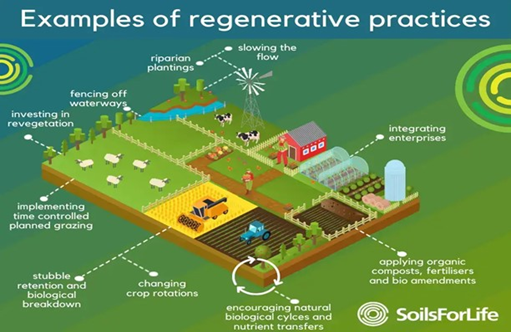
Where to use?
Paper III (Agriculture)
Map
- Pala wetland: It is the largest natural wetland in the Sahia district of Mizoram.Its geographical location falls under the Indo-Burma biodiversity hotspot and is therefore rich in animal and plant species. Recently it has been included in the Ramsar site.
- Sakhya Sagar: It is a human-made reservoir on the outskirts of Shivpuri town within the Madhav National Park.It is a habitat for thousands of migratory waterfowl and also mugger crocodile. With its inclusion as the Ramsar site, it becomes the second site after Bhojtal to become part of Ramsar convention.
- Lamheta: The first geological park of India will be built in Lamheta village of Jabalpur in Madhya Pradesh. It is among significant places in world, from geological point of view. Studies revealed that dinosaur fossils were recovered from this area. UNESCO has also recognised it as geo heritage site.
- Khangkhui Mangsor: The Khangkhui Cave, locally called as Khangkhui Mangsor, is essentially a natural limestone cave in The cave is about 15 km away on eastern side from Ukhrul town. Recently a colony of bats was evicted from a Khangkhui Mangsor cave system to make it tourist-friendly.
- Toranmal: Itis a hill station in the municipal council of the Nandurbar district in the Indian state of Maharashtra. It lies in the Satpura Range.
- Zirovalley: Ziro valley is a popular tourist destination in Lower Subansiri district of the central part of Arunachal Pradesh. It is famous for its natural beauty and is situated on the Apatani Plateau. Declared as a World Heritage Site by the UN as it is the cultural heritage site of the Apatani tribe.

Share the article
Get Latest Updates on Offers, Event dates, and free Mentorship sessions.

Get in touch with our Expert Academic Counsellors 👋
FAQs
Geography Current Affairs focuses on the contemporary issues, events, and developments in the field of geography. It covers recent geographical phenomena, environmental changes, geopolitical shifts, and related news. This differs from regular geography studies which may focus more on foundational concepts, historical contexts, and theoretical frameworks.
Updates are provided regularly to ensure that subscribers stay informed about the latest developments in geography. Typically, updates are provided on a fortnightly basis, depending on the frequency of significant events and changes in the field.
Absolutely. Geography Current Affairs serves as a valuable resource not only for Geography optional but also for GS papers, especially GS Paper 1 (covering Indian Heritage and Culture, History, and Geography of the World and Society) and GS Paper 3 (covering Technology, Economic Development, Biodiversity, Environment, Security, and Disaster Management). It aids in building a holistic understanding of various topics and strengthens answer-writing skills by incorporating contemporary examples and perspectives.
Geography Current Affairs holds immense importance for UPSC preparation, particularly for aspirants opting for Geography optional. It helps candidates stay updated with the latest developments, geographical phenomena, environmental issues, and geopolitical shifts worldwide, aligning them with the dynamic nature of the subject as tested in the UPSC examinations.

